International Monument at Birkenau
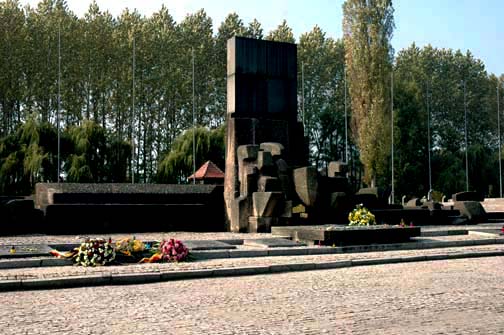
International Monument
at Auschwitz-Birkenau, 2005
The photograph above shows the International
Monument, which was erected in 1967 in the Auschwitz II camp,
known as Birkenau. The Monument is located at the western end
of the main camp road, between the ruins of Krema II and Krema
III, the crematoria buildings where the two largest gas chambers
at Birkenau were located.
The photo below shows the ruins of the
Krema III gas chamber in the background on the right. The ruins
of Krema II are behind the camera in this photo.
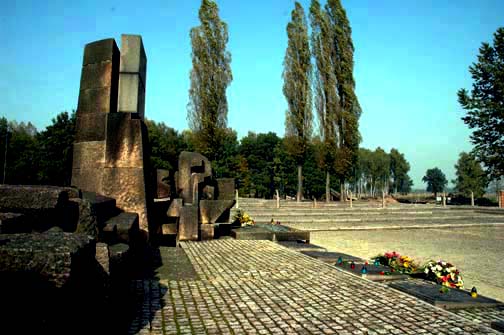 Monument on the left,
ruins of Krema III gas chamber on the right
Monument on the left,
ruins of Krema III gas chamber on the right
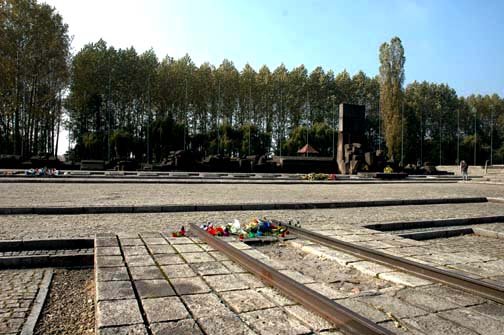
Railroad tracks end
in front of the International Monument
The photo above shows the railroad tracks
which were built in April 1944 to bring the Jews to the western
end of the Birkenau camp where they disembarked near the gas
chambers. Those who were selected for immediate death walked
directly to the Krema II and Krema III gas chambers that were
on either side of the tracks. Those who were selected to work
walked down the road behind the Monument to the Sauna where they took a shower and were given
striped uniforms to wear. The prisoners, in the cars at the far
end of the train, walked down a road that bisected the camp and
entered the gas chambers in Krema IV and Krema V which were on
the north side of the Birkenau camp, near the Sauna.
The main camp road is on the right in
the photo below; it ends where the cobblestones of the Monument
begin. Before the monument was built, the main camp road continued
on until it intersected another road which went north to Krema
IV and Krema V where two more gas chambers were located. The
Monument was built on top of the main camp road, which used to
continue on, past this intersection, to the fields outside the
camp.
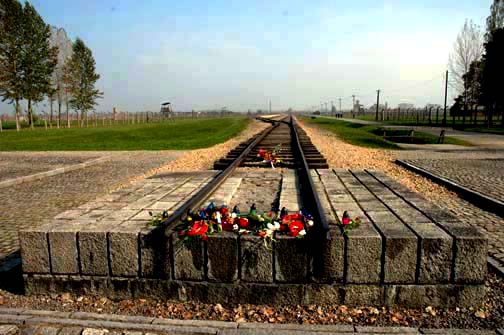 Railroad tracks go
one mile into the camp
Railroad tracks go
one mile into the camp
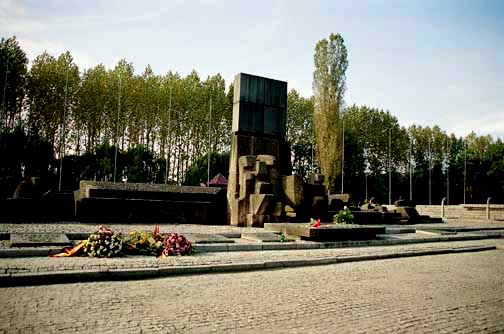
International Monument
at Birkenau
The Monument has a large area of wide
steps where a great number of people can gather. It is here that
ceremonies are held for visiting heads of state and large groups,
such as the high school students from all over the world who
are participating in the bi-annual March of the Living. The steps
are within a few feet of the ruins of Krema II and Krema III
where the Jews were gassed. The photo below shows the ruins of
Krema III with the steps of the monument in the foreground on
the right.
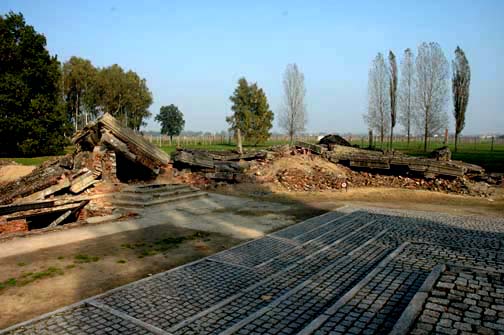 Ruins of Krema III
on the left, monument steps on the right
Ruins of Krema III
on the left, monument steps on the right
An international competition was held
to select the best design for the proposed Birkenau monument.
There were around 400 artists who entered a design.
The monument itself is quite large with
a jumble of dark stones that looked like grave stones or coffins
to me, but my 1998 tour guide said these stones were meant to
resemble the victims.
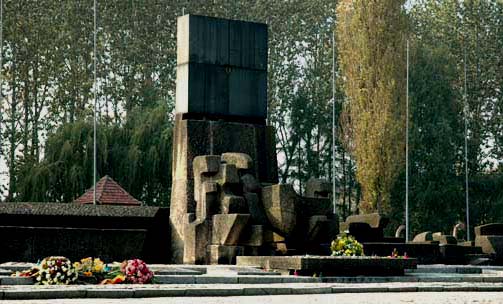 Stones at the monument
in honor of the victims
Stones at the monument
in honor of the victims
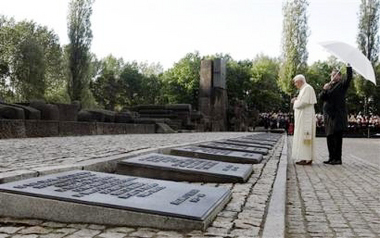 Pope Benedict at the
International Monument
Pope Benedict at the
International Monument
On the steps of the Monument, there is
a row of granite slabs, each with a metal plate on top which
has an inscription in a different language, including Yiddish,
English, and every major language of Europe. The granite slab
with a metal plate inscribed with English words stands alone
at the far right of the Monument, as you are facing it.
As shown in the photo below, the English
inscription reads:
FOR EVER LET THIS PLACE BE A CRY OF
DESPAIR AND A WARNING TO HUMANITY, WHERE THE NAZIS MURDERED ABOUT
ONE AND A HALF MILLION MEN, WOMEN AND CHILDREN MAINLY JEWS FROM
VARIOUS COUNTRIES OF EUROPE. AUSCHWITZ-BIRKENAU 1940-1945
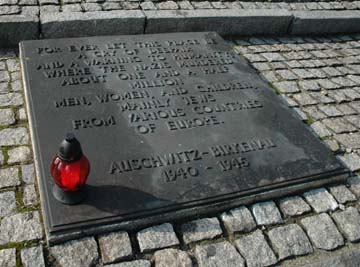 Plaque with English
words at International Monument, October 2005
Plaque with English
words at International Monument, October 2005
From 1986 to April 3, 1990, the words
on the English plaque read:
FOUR MILLION PEOPLE SUFFERED AND DIED
HERE AT THE HANDS OF THE NAZI MURDERERS BETWEEN THE YEARS 1940
AND 1945.
Four million was the number of Auschwitz-Birkenau
victims that the Soviet Union had included in their charges against
the Nazi war criminals at the Nuremberg International Military
Tribunal, which began in November 1945. After the fall of Communism
in 1989, the Soviet Union released the 46 death register books
(Sterbebücher) which they had captured when they liberated
the Auschwitz and Birkenau camps on Jan. 27, 1945. The books,
which were turned over to the International Red Cross, contained
the names of 69,000 prisoners who had died in the Auschwitz-Birkenau
camps from July 27, 1941 to December 31, 1943. The Auschwitz
I camp opened on May 20, 1940 and both camps were evacuated on
Jan. 18, 1945, so some of the death registers were missing. The
Red Cross extrapolated these figures and estimated that there
was a total of 135,000 registered deaths at Auschwitz-Birkenau.
The Jews who were gassed were not registered in the camp and
their deaths were not recorded.
The train records for the Jews who were
transported to Auschwitz have never been found, but it has been
estimated that a total of 1.3 million Jews were sent to Auschwitz
and around 200,000 were eventually sent to other camps after
being registered. Based on these figures, the total number of
deaths at Auschwitz-Birkenau is estimated to be 1.1 million.
Notice that the first inscription on
the plaques made no mention of the Jews who had died at Auschwitz-Birkenau,
since the Communist Soviet Union did not allow any religion.
This was corrected after the fall of Communism. According to
the Auschwitz Museum, 90% of those who died at Auschwitz-Birkenau
were Jews, but some historians say 95%.
The original plaques were removed in
1990 and in 1995, at the suggestion of Lech Walesa, the number
of deaths on the plaques was changed from 4 million to 1.5 million,
which includes the deaths in all three Auschwitz camps, known
as Auschwitz, Birkenau and Monowitz.
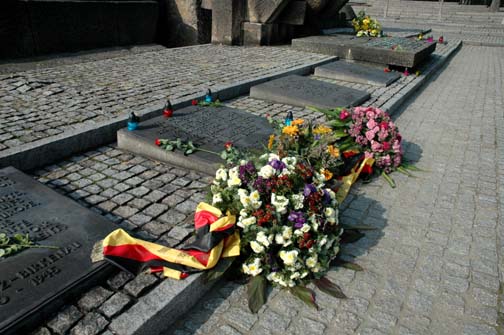 Flowers left by visitors
at the Monument
Flowers left by visitors
at the Monument
In their book entitled "Auschwitz
1270 to The Present," authors Van Pelt and Dwork wrote:
In the thirty-two months that Auschwitz
operated as a designated extermination center, from March 1942
to November 1944, between 1 million and 1.1 million people were
killed, or an average of 32,000 to 34,000 a month. During the
Hungarian action, the Germans, with dispatch and efficiency,
increased that average five-to-six fold.
This page was last updated on March 28,
2009
|